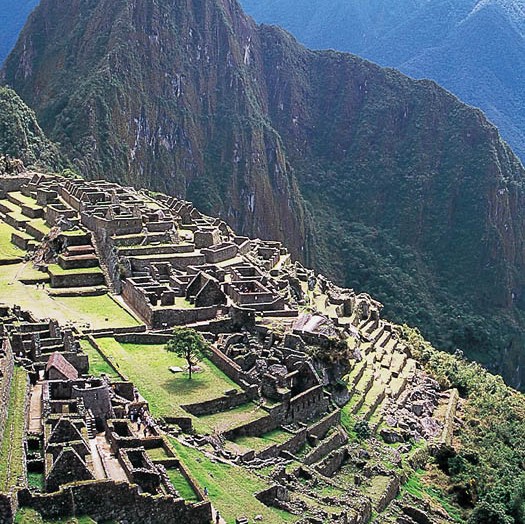World Heritage sites under scrutiny
World Heritage sites will be under the spotlight next month as the World Heritage Committee prepares to meet in Quebec City, Canada, from July 2-10.

Photo: IUCN/Pedro Rosabal
Background
They will discuss sites that should be added to the UNESCO World Heritage List, as well as existing World Heritage sites that are threatened. IUCN, the International Union for Conservation of Nature, advises the Committee on which natural and mixed sites should be added to the List. Together with UNESCO, IUCN also reports on the state of conservation of some 60 sites under threat, a number of which received joint monitoring missions during the past year.
Key Quotes
• “Natural World Heritage sites across the world are facing more and more threats,” says Julia Marton-Lefèvre, Director General of IUCN. “Mining, uncontrolled tourism and drastically declining wildlife populations are all taking their toll on these sites. The global community must do more to protect these priceless natural areas.”
• “World Heritage sites are supposed to be the crème de la crème of what the world has to offer – we should be taking better care of them,” says David Sheppard, Head of IUCN’s Protected Areas Programme. “I hope this World Heritage Committee will take the threats we have identified seriously and call on the states responsible to take action to save World Heritage sites in trouble.”
Key issues
• Existing World Heritage sites that are facing serious threats include:
Galápagos Islands, Ecuador
Placed on the list of World Heritage sites in danger last year, the Galápagos Islands continue to face threats from the large numbers of tourists that visit each year, illegal fishing and high and unregulated immigration. They are also under threat from introduced species, including goats, pigs, cows and hundreds of species of plants, although some have been removed from certain islands. IUCN recommends the Galápagos Islands stay on the danger list.
Machu Picchu, Peru
This well-known site, which lies at the end of the Inca Trail in the Andes, is facing serious threats. High visitor numbers, a lack of control over their entry to Machu Picchu, and uncontrolled growth of the nearby town, Aguas Calientes, are all major threats. There has been no public information about the very real threats of landslide, fire, building collapse and health risks associated with overnight stays in Aguas Calientes. Security measures taken over the last five months have failed to stop an increase in the number of visitors reaching Machu Picchu via unauthorized paths in the western part of the site. IUCN recommends this site is added to the list of World Heritage sites in danger.
Virunga National Park, Democratic Republic of Congo
This park has been on the list of World Heritage sites in danger since 1994. It faces threats from refugees, who set up home in the park, armed militia, and continued poaching and deforestation, particularly for fuel and illegal charcoal production. In 2007, 11 gorillas were slaughtered in Virunga, out of the 750 that remain in the wild. A joint monitoring mission by IUCN and UNESCO was organized. This recommended urgent action to withdraw non-strategic military postings, stop all production of charcoal and improve security in the park and on its periphery. IUCN recommends it stays on the danger list.
• Other existing World Heritage sites that will be reported on:
Western Caucasus, Russian Federation
This site extends over 275,000 ha of the western Caucasus mountains. It is one of the few large mountain areas of Europe that has not experienced significant human impact. However, developments for the Sochi 2014 Winter Olympic Games pose a major potential threat to the site. A joint IUCN and UNESCO mission found that the Sliding Centre (luge-bobsleigh), mountain Olympic village, and related infrastructure, as currently proposed, would affect some areas within the property, the boundary of the property, and winter wildlife feeding grounds and migration corridors of wildlife from the property. Roads and illegal logging also pose threats.
Everglades National Park, United States of America
This park was removed from the list of World Heritage sites in danger last year, against IUCN’s advice. It had been on the danger list since 1993 and in IUCN’s opinion it still faces threats. IUCN is very concerned that a number of corrective measures have not been implemented. Urban encroachment, agricultural fertilizer, mercury contamination of fish and wildlife and lower water levels due to flood controls threaten the park. The park is also at serious risk from climate change and subsequent sea-level rise. IUCN calls on the USA to carry out a vulnerability assessment and develop a risk reduction strategy for this.
For more information, please contact:
• Sarah Halls, IUCN Media Relations Officer, t +41 22 999 0127, m +41 79 528 3486 e sarah.halls@iucn.org
• Borjana Pervan, IUCN Communications Officer, t +41 22 999 0115, m +41 79 857 4072 e borjana.pervan@iucn.org
About IUCN
IUCN, the International Union for Conservation of Nature, helps the world find pragmatic solutions to our most pressing environment and development challenges by supporting scientific research; managing field projects all over the world; and bringing governments, NGOs, the UN, international conventions and companies together to develop policy, laws and best practice.
IUCN is the world’s oldest and largest global environmental network. IUCN is a democratic union with more than 1,000 government and NGO member organizations, and almost 11,000 volunteer scientists in more than 160 countries. IUCN’s work is supported by over 1,000 professional staff in 60 offices and hundreds of partners in public, NGO and private sectors around the world.
www.iucn.org



